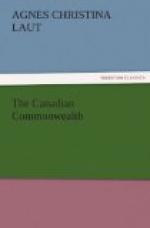Hudson Bay itself is in area about the size of the Mediterranean. Because it is so far north the impression prevails that it is afloat with ice. This is a false impression. Hudson Bay lies in the same latitude as the North Sea and the Baltic, which are freighted with Russian and German commerce, but the climate, of course, is colder. The ice, which has given the great inland sea its ill repute, comes from the Pole and goes out through the Straits, seldom coming down the Bay in the season of navigation.
The Straits are the real crux of the Hudson Bay route to Europe, and there is no narrow neck of land to cut a way of escape through to open sea as at Kiel and Cape Cod. The Straits have been navigated by fur-traders since 1670, but the fur-traders could take a week or a month to the four hundred and fifty miles of Straits. They could afford the time to float back and forward with the ice packs for six weeks, and as many as seven vessels have been wrecked in ten years. To this tale of wreckage in the Straits, friends of the Hudson Bay route answer as follows:
First, the fur-traders’ vessels were little discarded admiralty vessels of small tonnage and rickety construction. Give us ice jammers such as the Russians use on the Baltic, built narrow and high of oak, not steel, to ride and crush down through the ice; and we can take care of high insurance rates. Second, the Straits are still an utterly uncharted sea four hundred and fifty miles long and from seventy to one hundred and fifty wide. This is not so long as the passage up the St. Lawrence. In such an inland sea as these Straits there must exist safe as well as unsafe channels, shelters, smooth reaches. Let us get the Straits charted and marked with buoys, with telegraph and cable points, and we shall navigate these four hundred and fifty miles. The questions of lighthouses need not bother the Straits, for the season of navigation is also the season of long daylight.
V
Three advantages must be put on the credit side of the Hudson Bay route:
Distances to tidewater cut by half.
Distances to Europe cut by a third.
Rates reduced on grain as eight to one.
Against these advantages must be placed three handicaps:
The danger of an uncharted sea in the Straits.
High insurance.
Necessity for enormous elevator and storage room.
Mr. Hill’s wheat country may begin wheat cutting in July. The Canadian Northwest is lucky if it cuts before the eighth of August. Consider the area of the big wheat farms! The whole of August is taken up with cutting and threshing. It is September or October, before the wheat is hauled to market, and it is November before it reaches seaboard. In November navigation on the Bay closes, and one hundred, perhaps two hundred million bushels of wheat must be held by the farmers, or the elevators, till May. This means interest on money out of the farmer’s pocket for six months, or storage charges. On the other hand, there will be no danger of stored wheat “heating” on the Bay. The cold there is of too sharp a type, but this is a danger in many of the all-the-year-round open harbors.




